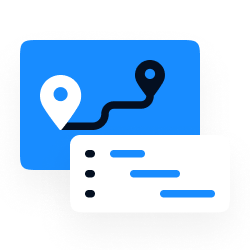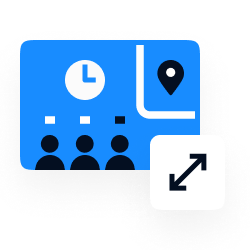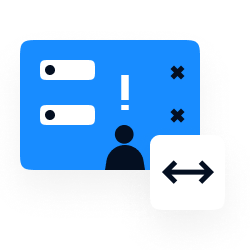Route Planning Basics

Whether you run a large enterprise or a small business, you’re probably looking for ways to save time and money. Effective route planning is one of the best ways to drive business efficiency and cost savings for delivery, field services, or logistics companies, especially since labor and fuel are two of the most costly operational needs. Imagine being able to save 40% of your time and money every day, with 7x faster planning.
Route planning involves calculating the most efficient route between stops. You might be thinking, “That seems pretty straightforward!” Here’s the thing, it’s more complicated than you think.
The calculations get more complex when the number of destinations on a route grows. With just fifteen stops, there are over 87 billion possible round trips, and that doesn’t take into account real-world business constraints that add even more complexity, like employee availability, customer time windows, order priorities, and much more. Therefore, route planning is not as simple as typing addresses into Google Maps and hitting the road.
Fortunately, there are route planning solutions available that are easy to implement. In this guide, we’ll explain what route planning is and how you can leverage it to benefit your business.
To navigate to the sections that interest you the most, see below:
- What Is Route Planning?
- Why Is Planning a Route Important?
- How to Do Route Planning
- What Is the Best Route Planner to Use?
What Is Route Planning?
Route planning is the process of planning and optimizing routes to get the most value out of your fleet of vehicles, get the most orders completed, or get the most jobs done. This term is often used interchangeably with route management and route optimization; all of these have the goal of reducing mileage, gas usage, vehicle wear and tear, and driving hours while completing each order as fast and efficiently as possible.
Route planning solutions use advanced algorithms leveraging data science and/or AI to find the most efficient and practical path to complete the task. An effective route planning platform will easily meet your workforce and management needs while enhancing your customer service.
What Is Route Planning and Monitoring?
Route planning involves strategically building routes designed to make the most of limited resources while ensuring all tasks are correct and on time. Route monitoring works in tandem with that goal by giving visibility into the activity on those routes.
Let’s say a route is set for a driver or field service technician. Instead of setting the route and hoping your team follows it, route monitoring shows the driver/tech’s progress as they go. It’s an easy way to see the progress of your fleet in real time and overcome unexpected delays, breakdowns, or other last-minute deviations from the plan.
Route monitoring removes the element of surprise and empowers business owners to make decisions in real time. This transparency also allows you to better communicate with your customers when they should expect their delivery or service.
Route planning and monitoring positively impacts the performance of your fleet and your customers’ satisfaction.
Why Is Planning a Route Important?

Effective route planning is fundamental for organizations seeking to enhance their operational efficiency. This enhanced efficiency can positively influence the company’s financial performance while benefiting business owners, managers, drivers, and customers alike. Thoughtfully planned routes have the potential to significantly improve a business’s performance, help reduce fuel costs, and optimize driver productivity. Consequently, all stakeholders enjoy the advantages of improved route planning.
Moreover, route planning streamlines the responsibilities of fleet managers and operations teams, enabling them to monitor their drivers or field technicians effectively while addressing any real-time challenges that may arise. In addition, it facilitates clearer communication with customers.
While a basic route plan may suffice to navigate from point A to point B, an optimized route takes into account various factors to ensure tasks are completed in a more timely and efficient manner.
For instance, in a typical scenario involving basic route planning, Company ABC may need to visit ten different locations with two drivers. By using a standard mapping tool, they manually plot routes for each driver based on proximity. It is essential for the dispatcher to consider any specific requirements, such as customer availability or specialized skills, without automation. Although all the stops are made, the route may not be the most efficient, resulting in potential time loss due to manual adjustments.
Conversely, let’s examine a situation where route optimization is implemented: Company ABC has the same ten destinations to visit with two drivers and is keen on establishing the most efficient routes available. In this case, they must consider driver availability, vehicle capacity, and any necessary special equipment. By utilizing automated route planning software, they can devise a plan that encompasses all critical elements, allowing drivers to complete their routes more quickly and with decreased fuel costs.
While devising a straightforward route may appear manageable, optimizing it for maximum efficiency presents a more significant challenge. Organizations that prioritize efficiency often turn to route planning software to identify opportunities for improvement and thoughtfully consider the necessary adjustments.
5 key benefits of route planning
Route planning is critical for delivery, field service, and logistics businesses and offers multiple benefits.
1. Reduce costs and increase revenue
A route planning tool can automatically account for all of the complex factors that make planning challenging, including: mileage, regulated driver breaks, employee availability, customer availability (for example, only Mondays and Wednesdays), and more. Using the most efficient routes possible lowers your labor and fuel costs; maximizing your fleet allows each driver to complete more work overall, increasing your revenue.
2. Scale up planning without adding extra resources
If you’re not using route planning software, your team is likely spending hours, if not days, trying to stay organized and on top of shifting scheduling needs. Last-minute changes or additions are nearly impossible. With a route planner, you can cut that time down to minutes, even while planning several weeks at a time.
3. Improve customer satisfaction
Route planning software isn’t just for optimizing your fleet. Additional features like SMS messaging, digital proof of delivery/service, live tracking, and real-time ETAs allow you to stay in close contact with your customers so they know exactly what to expect, increasing their satisfaction and brand loyalty.
4. Improve employee retention
Work-life balance is a key component in employee satisfaction and retention. Being able to equitably spread orders or calls across your team ensures that overtime is kept to a minimum while workloads feel balanced and fair.
5. Respond in real time to changing needs
In a perfect world, routes could be planned weeks in advance and then executed flawlessly with no deviations. But in the real world, things are constantly changing – a customer may need a last-minute address change or cancel entirely, a new priority order can come in unexpectedly, or staff may be sick. Manually replanning on the fly can be a herculean task, but route planning software can replan as many times as you need, in minutes, even after your fleet is on the road.
How to Do Route Planning
A well-planned route doesn’t just come together by chance, it takes a thoughtful approach and consideration of many different factors. Without specialized software, people use maps and their familiarity with the area to plan a route, or they may use online mapping tools that plot destinations but fail to optimize routes.
Online tools like Google Maps or MapQuest might be effective options for planning a road trip route, but the lack of route optimization capabilities makes these free tools unviable for business use.
For business owners running a delivery or field service operation, you’ll benefit from using dedicated route planning software built specifically to handle the needs of companies with complex logistics.
When relying on spreadsheets and simple tools, you’ll need a lot of local and institutional knowledge to complete the job. Here are a few considerations you’ll have to keep in mind if you elect to plan manually:
Demand. Ensure you are utilizing the right number of drivers and vehicles to meet your customers’ needs. Under-utilization means wasted time and resources, while over-utilization means costly overtime and poor work-life balance for your drivers.
Complicating factors. Ensure that your planning staff is taking into account all complexities of your operation, including both vehicle and staffing attributes. Vehicle capacity and special features like refrigeration or lift gates are just a few things to keep in mind. In addition to your fleet vehicles, your staff will have various constraints, too, like schedule availability, wages, and special skills or certifications.
Be ready to adapt. To avoid delays – or worse, skipped stops – you’ll need to be ready to change things as the unexpected arises. You may receive an urgent unplanned order, or a driver may call in sick. Your plan will need to adapt and change to accommodate the new needs. Using software for route planning is the simplest and most effective way to plan routes for businesses of any size, regardless of industry.
Can Google Maps do route planning?
Not really. Google Maps has over 150 million monthly users, so it’s no secret that it can be used to figure out a route to get you where you need to go. The perks of Google Maps are that it’s a completely free planning system that offers a street view option in most locations, offline mode for areas with low cellular connectivity, and hands-free navigation with voice directions.
Even though Google Maps is capable of very basic route planning free of charge, and is a popular choice for everyday users, it leaves much to be desired for professional use. Unlike software built specifically for businesses, Google Maps only accommodates limited stops, doesn’t always prioritize the fastest route, and has few of the functionalities we’ve outlined as highly useful to professionals.
Can MapQuest do route planning?
Just like Google Maps, MapQuest is capable of the most basic route planning and offers what could be considered a free route planner app, but there are limitations. If you’re an infrequent user with relatively simple needs, e.g., only one driver with few stops, it might get the job done.
Businesses looking for effective route planning need to control inputs like delivery time windows. They often require real-time updates that they can use to manage their resources and communicate status updates to customers. MapQuest doesn’t offer these features. Therefore, it might do the trick for personal use, but making it work for professionals is a stretch.
What Is the Best Route Planner to Use?
The best route planner for the job depends largely on the case. If you’re planning a route for a road trip or only need to map a route occasionally, you might be able to make do with a minimal software solution like the AAA route planning TripTik software, Google Maps, or the MapQuest route planner.
On the other hand, if you’re a business operator looking to maximize your business’s performance while enhancing the bottom line, you’ll benefit from implementing a full-service solution that offers a wider feature set. One that leverages data, data science, AI, and a best-in-class route optimization algorithm that can handle every order variable in seconds.
The best route planning software must have the features your business needs.
What is the best free route planner?
Everyone loves a good deal, and what could be better than free? Unfortunately, a free route planner is a bit too good to be true. Free mapping tools can’t account for all of the real-world scenarios that businesses face.
The closest solution to a free route planner is signing up for a free trial with a paid software. That way, you get to see whether the features align with what you need and you can assess how it might impact your business. Many route planner tools have generous free trial periods, and often the financial benefits of a paid solution far outweigh the costs.
Best Route Optimization Software
If you manage a fleet of delivery vehicles, a field sales team, or perform services on-site, you will notice significant operational efficiencies by utilizing route optimization software. With better route planning, fleet-based businesses can save more time and fuel while delivering better customer service.
The big question is…which software to choose? What is the best route optimization software, “free” or paid? There are many options to choose from, so the best place to start is to determine the features you should be looking for.
At a basic level, route optimization software should help drivers spend less time on the road, increase the number of stops they can make daily, save route planning time, and reduce fuel costs.
On a more advanced level, these are some of the key features you’ll want to look for:
Speed & automated planning
Imagine reducing your time spent on route planning from hours to seconds. Automated planning allows you to simply import a list of your destinations, click a button, and have the most efficient routes mapped out for you. The best route planners adjust and reschedule your routes as changes occur from moment to moment, automatically sending notifications to customers, drivers, and dispatchers to keep everyone on the same page.
Adaptability
Whether you have vehicle specifics, e.g., loading ramps, temperature control, etc., or time-based requirements, an effective route planning solution will allow you to easily optimize routes and schedules by allocating assets where needed. Whatever your business criteria are, the route planning platform needs to be able to take this into account when planning your routes. Adaptability to your existing workflows is critical as it means you can now automate your manual processes from end to end.
Intelligence
There’s a lot of data to be analyzed in building, operating, and optimizing your routes. Without the ability to sort that data efficiently, you can’t take advantage of potential insights that help you improve the efficiency of your routes. That’s why you’ll want to choose a route optimization software that generates and sorts route data to identify areas of opportunity and determine where to make adjustments.
Real-time tracking
Utilizing real-time data eliminates the unknown. Using route planning software that offers real-time tracking allows you to keep track of your drivers, view ETAs, and deliver up-to-the-minute updates to customers. It also allows managers to make informed decisions when challenges arise and adjust routes in real time to handle things like a driver calling in sick or last-minute orders.
Mobile friendly
The best route optimization software, free or paid, should offer a mobile-friendly solution. That means an app for drivers or field service workers to receive and send important updates. A well-developed app will offer proof of delivery tools like the ability to capture digital signatures, photos, and notes.
Commercial navigation / truck routing
If you have a fleet that includes large commercial vehicles or you work with hazardous materials, you need a solution that can build routes with these considerations in mind. Commercial navigation is essential and it should be aligned to your routing optimization to ensure that your drivers or techs follow the best step-by-step routing in conjunction with the route plan.
API integration
You want to ensure your systems speak to each other seamlessly. That means choosing a route planning software free of headaches (or as few as possible). A large factor to consider when minimizing hassles is finding a solution that offers an easy-to-use API that supports end-to-end integration with your CRM, POS, ERP, FSM, or any other system you have in place.
Customer feedback
Getting customer feedback from your clients should be easy, and the best route-planning solutions automate the process. With the automation of customer feedback, customers are prompted to give feedback once the delivery or service has been completed. That gives businesses another data point to improve their operation.
The bottom line
Effectively managing your fleet of drivers or field techs can lead to significant reductions in operational, fuel, and payroll costs—benefits that both small to medium-sized businesses and larger enterprises can appreciate.
With the help of modern route optimization software, your dispatchers or managers can save countless hours of planning each day, allowing them to concentrate on growing their business and enhancing customer experience.
By utilizing proper route planning, your business could potentially double its order capacity while cutting mileage costs by up to 40%, all without expanding your fleet size or number of drivers/techs.
There are numerous route planning solutions available today. Your primary focus should be on identifying the unique needs of your business and the essential features that will streamline your operations. Are you trying to solve for speed, adaptability, added intelligence, or all of these at the same time, look for solutions that improve your business workflows and efficiencies in these areas.
Once you’ve determined the necessary functionalities, take the time to explore some of the most reputable options on the market and consider leveraging them for your benefit.
Try OptimoRoute™ for Free
No installation or credit card required





